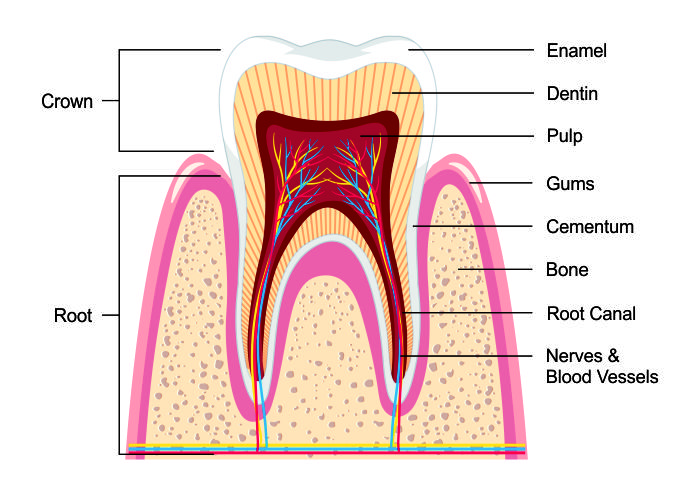
Structure Of A Tooth
Every tooth has two sections: a crown, the visible part of the tooth above the gum line, and one or more roots, which anchor the teeth within the jaw. Each tooth has three basic layers: an outer layer of hard enamel (which protects the ‘crown’) or cementum (which covers the ‘root’), a middle layer that is softer, called the ‘dentin’, and the inside of the tooth called the ‘pulp’.
The ‘pulp’ is living tissue containing nerves, blood vessels, and connective tissue. The ‘pulp’ is typically located in the center of the tooth, ie center of the ‘crown’ and then extends towards the tip of the tooth, ie through the ‘root’ through a canal, called the ‘pulpal canal’.
What Are The Causes For Root Canal?
There are many reasons for which the ‘pulp’ can get irritated, inflamed, or infected. The most common cause is ‘tooth decay’ or ‘dental caries’, which when it starts at the enamel and spreads through the dentin, if not treated (by a ‘dental filling’) can extend further in to the tooth and hit the ‘pulp’.
When the dental decay touches/reaches the pulp, it’s often too late to save the ‘pulp’, which in turn gets inflamed and eventually dies. When this gets worse, it causes an infection under and around the tip of the root. When tooth pulp is infected or dying, it can’t be restored.
Without treatment, tooth extraction is often the option. An infection in the pulp can spread to the gum tissue, the jawbone, and other parts of the body.
A root canal procedure is intended to save a tooth (to save the crown and root parts of the tooth). It can prevent tooth loss and prevent a more widespread infection. This is done by removing the infected pulp tissue, cleaning up the canal that houses the ‘pulp’ and then filling these canals with a definitive material.
Other Causes for a Root Canal
Even with the protective layers surrounding the ‘pulp’, the tooth pulp is vulnerable to infection and injury:
What Is The Root Canal Procedure?
A root canal procedure is relatively straightforward. If you are anxious about the procedure, your dentist can recommend sedations options.

Symptoms of Pulp Infection
A tooth that needs root canal treatment might be symptom-free, but any of these symptoms are strong indications that the pulp has suffered infection or injury:
- Persistent tooth pain, which can be dull or sharp and severe
- Pain when chewing or when any pressure is placed on the tooth
- Prolonged sensitivity to heat or cold
- A cracked, broken, darkened, or discolored tooth
- Gum tissue near the tooth which is sore, red, or swollen
- A pimple-like bump on the gums that persists or keeps recurring. This is the sign of an abscess, an infection in the gum or bone near the root of the tooth.
Who performs Root Canal Treatment?
A root canal is typically performed by specialist called an ‘Endodontist’ who is a dentist who has undergone 3 years of additional training in root canal treatment. At Dental Lavelle, we have 2 endodontists. Sometimes, with front teeth (that have a well defined single straight forward canal) can be treated by experienced General Dentists as well.
Call your dentist immediately if you have any symptoms of pulp infection or injury. Prompt endodontic treatment can relieve tooth pain and prevent further infection. And, with proper dental care and regular checkups, your restored tooth can last a lifetime.


